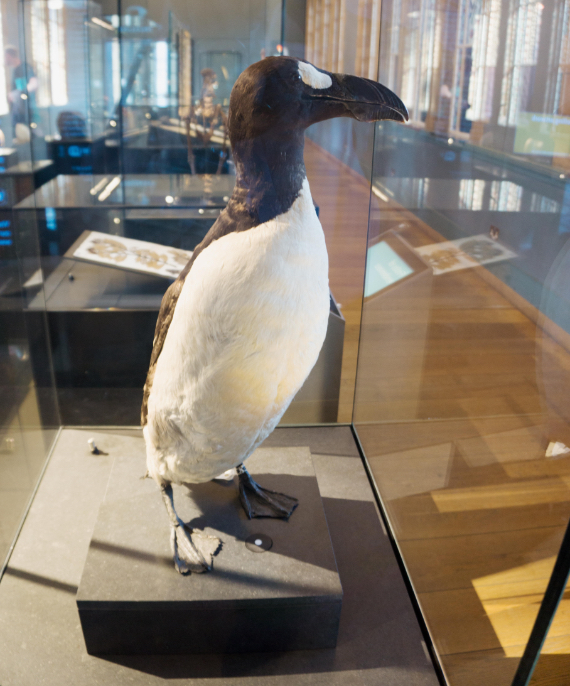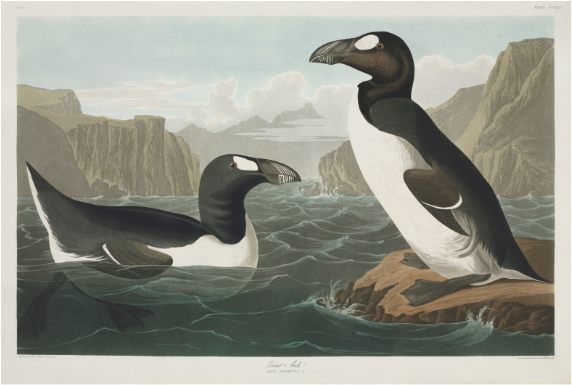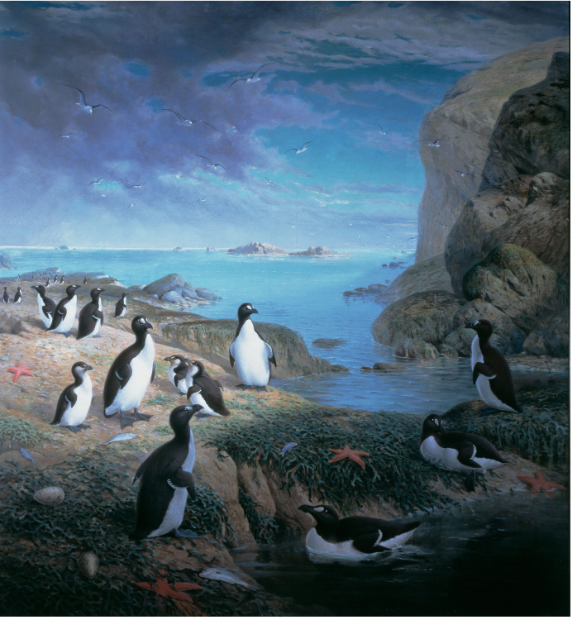If someone told you that penguins were extinct, you might think they were talking about the foreseeable future threat of climate change, or that they were making it up. But it is literally true: what we now call penguins are so named because of their physical resemblance—though they are only distantly related—to the original penguin, which, unlike the birds we know today as penguins, lived not in the Antarctic but in the Arctic, and went extinct in the mid-19th century: the great auk, or Pinguinus impennis; a unique species in the human era, and the only penguin of our time to bear this scientific name.

Arctic exploration preceded Antarctic exploration for obvious reasons: while Antarctica has no indigenous population and is just a vast continent of white desert, the northern polar regions have been inhabited by humans for 5,000-6,000 years. But man’s relationship with the great auk actually goes back much further: this large, 80-centimetre tall, black and white bird, which was unable to fly but was a superb swimmer, appears among the remains or depictions found in Neanderthal settlements dating back 100,000 years.
The road to extinction: from plate to pillows
In prehistoric times, the great auk extended southwards along the coasts of the North Atlantic, in North America as far as Florida and Bermuda, and in Europe as far as the Mediterranean and Madeira, and there are even remains in some of these regions in our own era. In historical times, its presence in Europe was in decline. The vast majority of bones have been found in middens (layers of human-generated food scraps), revealing what our primary relationship with these birds was: eating them. But interestingly, in more modern times, the main reason for hunting them was for their down, which was used to make pillows. And so, from a species estimated by experts to have numbered in the millions, its distribution retreated northwards and, apart from sporadic sightings, disappeared from the European continent by the mid-16th century.

In the Arctic, the bird was also a popular food for indigenous people, but the human population there was much smaller. However, it continued to be hunted during the golden age of navigation, when the great auk, well known to explorers and sailors, revealed the proximity of the coasts of Newfoundland and the Labrador Peninsula. Despite this, it was never studied by scientists. And although there are numerous illustrations, only one drawing is known to have been copied from life; the model was the pet bird of the Danish physician and naturalist Ole Worm, who published the figure in his 1655 work Museum Wormianum.
In 1758, the Swedish naturalist and botanist Carl Linnaeus included the great auk among the 4,400 described animal species name in his Systema Naturae, under the binomial scientific name Alca impennis, referring to its assumed kinship with the common auk (Alca torda), a similarly distributed bird that flies. In 1791, it was reclassified into its own genus, Pinguinus impennis. The English name “penguin”, which has been used to designate this bird since the 16th century, has a debated origin: it may come from the Spanish, Portuguese and French names for the species, which originate from the Latin pinguis, meaning “plump”. But some argue that “penguin” may derive from the Welsh pen gwyn, which means “white head”.
A case of convergent evolution
In any case, the reclassification recognised that the penguin deserved a separate genus from its closest relatives, the auklets, puffins, guillemots and others, all of which fly; gulls, terns and other waterfowl are also somewhat more distant relatives. It is now known that the great auk had a larger, flightless close cousin, Pinguinus alfrednewtoni, in the Pliocene Era, about 5 million years ago. But when European explorers discovered other penguin-like, flightless birds in the southern hemisphere, they gave them the same name. However, the Spheniscidae, the family of today’s penguins, are evolutionarily distant from the original penguin.

The similarity between the true penguin of the north and the false penguins of the south is a case of convergent evolution, in which distant species develop similar adaptations: in both cases, they abandoned flight and specialised in swimming, transforming their wings into paddles. But because they started from different origins, their tools also show slight differences. A 2020 study by the Universities of Cambridge and Kyoto showed that they used different ligaments to stiffen their wings: the great auk used a ligament inherited from its flying ancestors, while penguins did not have one and adapted others. According to study co-author Junya Watanabe, “ancestral starting points have a strong impact on the minor differences we see in convergently similar species like penguins and auks.”
On 3 June 1844, the last two confirmed great auks were killed on the islet of Eldey off the coast of Iceland. There is a report of a subsequent sighting in 1852, but that was it. The species was known to be on the verge of extinction In both Europe and America; the first conservation efforts date back to 1553, but to no avail. In 2019, a study confirmed something that surprises no one: “even if the great auk had not been under threat by environmental change, human hunting alone could have been sufficient to cause its extinction.” Today, the memory of the penguin remains, along with the iconic dodo, as a symbol of the species that humans have exterminated.
Comments on this publication